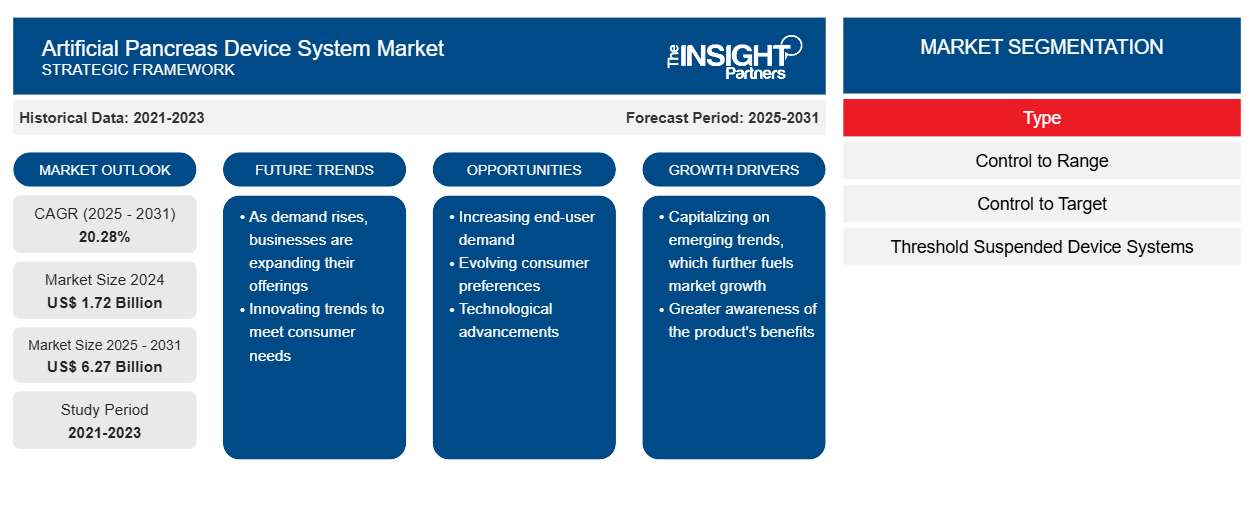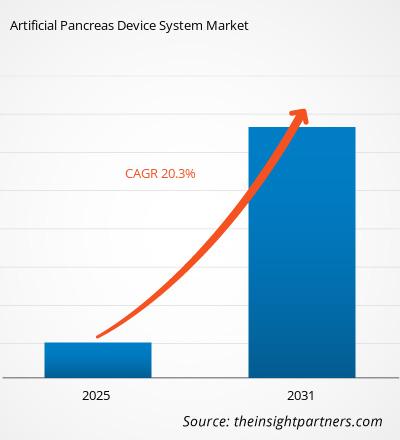Se proyecta que el mercado de sistemas de dispositivos de páncreas artificiales alcance los 3.585,75 millones de dólares en 2031, desde los 1.190,23 millones de dólares en 2022; se estima que crecerá a una CAGR del 20,28 % entre 2022 y 2031.
Los sistemas de páncreas artificiales imitan fielmente la función reguladora de la glucosa del páncreas en buen estado. El dispositivo no solo monitoriza los niveles de glucosa en el cuerpo, sino que también ajusta automáticamente la distribución de insulina para reducir los niveles de glucosa en sangre y la incidencia de hipoglucemia con poca o ninguna intervención del paciente. Según la Administración de Alimentos y Medicamentos (FDA), el uso de un páncreas artificial se asocia con un mejor control de la glucemia en personas con diabetes tipo 1, en comparación con el tratamiento estándar.
El mercado de sistemas de dispositivos de páncreas artificial está segmentado por tipo y ubicación geográfica. Según la geografía, el mercado se divide en Norteamérica, Europa, Asia Pacífico, Oriente Medio y África, y Sudamérica y Centroamérica. El informe ofrece información y un análisis exhaustivo del mercado, con énfasis en parámetros como las tendencias, los avances tecnológicos y la dinámica del mercado, además de analizar el panorama competitivo de los principales actores del mercado a nivel mundial.
Obtendrá personalización en cualquier informe, sin cargo, incluidas partes de este informe o análisis a nivel de país, paquete de datos de Excel, así como también grandes ofertas y descuentos para empresas emergentes y universidades.
Mercado de dispositivos de páncreas artificiales: Perspectivas estratégicas

-
Obtenga las principales tendencias clave del mercado de este informe.Esta muestra GRATUITA incluirá análisis de datos, desde tendencias del mercado hasta estimaciones y pronósticos.
Perspectivas del mercado
La creciente prevalencia de la diabetes impulsa el mercado de dispositivos de páncreas artificiales
La diabetes es una enfermedad crónica potencialmente mortal sin cura especializada. Se debe principalmente a la incapacidad del organismo para producir o utilizar eficazmente la hormona insulina. Es una de las mayores emergencias sanitarias mundiales del siglo XXI. La diabetes impide que el organismo regule adecuadamente los niveles de glucosa en sangre. Existen dos tipos de diabetes: diabetes tipo 1 (también conocida como diabetes insípida) y diabetes tipo 2 (también llamada diabetes mellitus). La obesidad, el sedentarismo y los hábitos alimentarios poco saludables son los principales factores de riesgo asociados al rápido aumento de la población diabética.
Según la Federación Internacional de Diabetes (FID), en América del Norte, se espera que el número de personas con diabetes aumente de ~46 millones en 2017 a ~62 millones para 2045; es probable que la prevalencia de la enfermedad aumente en ~35% durante el período de pronóstico. Según la Asociación Americana de Diabetes, ~30,3 millones de personas, es decir, hasta el 9,4% de la población de EE. UU., padecieron diabetes; de estos, 1,25 millones de niños padecieron diabetes tipo 1, en 2017. Los Institutos Nacionales de Salud también afirman que la incidencia de la diabetes tipo 1 está aumentando rápidamente en todo el mundo, afectando a un número significativo de niños y adolescentes. Según la misma fuente, ~84 millones de personas en el sudeste asiático padecieron diabetes en 2017. De estos pacientes, 149.300 niños padecen diabetes tipo 1 y requieren una dosis diaria de inyecciones de insulina. La diabetes tipo 2 es la forma más prevalente de diabetes y ha aumentado junto con los cambios culturales y sociales. En los países de altos ingresos, hasta el 91% de los adultos diabéticos tienen diabetes tipo 2. Según la FID, aproximadamente 425 millones de personas en el mundo vivían con diabetes en 2017, y se espera que la cifra alcance los 629 millones para 2045.
La diabetes de todo tipo puede provocar diversas complicaciones en diversas partes del cuerpo y aumentar el riesgo general de muerte prematura. Las principales complicaciones asociadas con esta enfermedad son infarto de miocardio, accidente cerebrovascular, insuficiencia renal, amputación de piernas, pérdida de visión y daño nervioso. Los pacientes con diabetes requieren monitoreo frecuente y administración externa de insulina.
Información sobre tipos
Según el tipo, el mercado de dispositivos de páncreas artificial se segmenta en sistemas de suspensión de control a rango, control a objetivo y umbral. En 2022, el segmento de dispositivos de suspensión de umbral tuvo la mayor participación de mercado. Se espera que este segmento registre la CAGR más alta entre 2022 y 2031. Con los sistemas de suspensión de umbral, también llamados sistemas de suspensión de glucosa baja, la administración de insulina se suspende durante un tiempo determinado cuando dos niveles de glucosa están por debajo de un nivel bajo especificado, lo que indica hipoglucemia. Un dispositivo de suspensión de umbral ayuda a revertir la caída de los niveles de glucosa en sangre. Con los sistemas de suspensión de umbral, también llamados sistemas de suspensión de glucosa baja, la administración de insulina se suspende durante un tiempo determinado cuando dos niveles de glucosa están por debajo de un nivel bajo especificado. Los dispositivos de suspensión de umbral no pueden responder a un evento de baja glucosa en sangre (hipoglucemia).
El lanzamiento de productos y las fusiones y adquisiciones son estrategias muy utilizadas por las empresas que operan en el mercado global de sistemas de dispositivos de páncreas artificial. A continuación, se enumeran algunos de los desarrollos de productos más recientes:
- En junio de 2021, Medtronic recibió la marca CE para el sistema MiniMed 780G para curar a pacientes con diabetes tipo 1 de entre 7 y 80 años.
- En abril de 2022, Abbott colaboró con Ypsomed y CamDiab para llevar el sistema de páncreas artificial a Europa.
- En enero de 2021, Medtronic lanzó su sistema MiniMed 780G en el Reino Unido. Se trata de un avanzado sistema híbrido de administración de insulina de circuito cerrado que se utiliza para el tratamiento de la diabetes tipo 1 en personas de entre 7 y 80 años.
Segmentación del mercado de sistemas de dispositivos de páncreas artificiales
En cuanto a su tipo, el mercado de sistemas de dispositivos de páncreas artificial se segmenta en sistemas de control por rango, control por objetivo y dispositivos suspendidos de umbral. Geográficamente, el mercado se divide en América del Norte (EE. UU., Canadá, México), Europa (Francia, Alemania, Reino Unido, Italia, España y resto de Europa), Asia Pacífico (China, Japón, India, Australia, Corea del Sur y resto de Asia Pacífico), Oriente Medio y África (Arabia Saudita, Sudáfrica, Emiratos Árabes Unidos y resto de Oriente Medio y África), América del Sur y Central (Brasil, Argentina y resto de América del Sur y Central).UAE, and Rest of Middle East & Africa), South and Central America (Brazil, Argentina, and Rest of South and Central America)
Perfiles de empresas
- Desafiado
- Typezero Technologies, Inc Technologies, Inc
- Corporación Insulet Corporation
- Bigfoot Biomedical, Inc
- Medtronic
- Dexcom, Inc
- Admetsys
- Beta Bionics
- Cellnovo
- Tandem Diabetes Care, Inc
Alcance del informe
Perspectivas regionales del mercado de dispositivos de páncreas artificiales
Los analistas de The Insight Partners han explicado detalladamente las tendencias regionales y los factores que influyen en el mercado de sistemas de dispositivos de páncreas artificial durante el período de pronóstico. Esta sección también analiza los segmentos y la geografía del mercado de sistemas de dispositivos de páncreas artificial en América del Norte, Europa, Asia Pacífico, Oriente Medio y África, y América del Sur y Central.
Alcance del informe de mercado del sistema de dispositivo de páncreas artificial
| Atributo del informe | Detalles |
|---|---|
| Tamaño del mercado en 2024 | 1.720 millones de dólares estadounidenses |
| Tamaño del mercado en 2031 | 6.270 millones de dólares estadounidenses |
| CAGR global (2025-2031) | 20,28% |
| Datos históricos | 2021-2023 |
| Período de pronóstico | 2025-2031 |
| Segmentos cubiertos |
Por tipo
|
| Regiones y países cubiertos |
América del norte
|
| Líderes del mercado y perfiles de empresas clave |
|
Densidad de actores del mercado de sistemas de dispositivos de páncreas artificiales: comprensión de su impacto en la dinámica empresarial
El mercado de sistemas de dispositivos de páncreas artificial está creciendo rápidamente, impulsado por la creciente demanda de los usuarios finales debido a factores como la evolución de las preferencias de los consumidores, los avances tecnológicos y un mayor conocimiento de los beneficios del producto. A medida que aumenta la demanda, las empresas amplían su oferta, innovan para satisfacer las necesidades de los consumidores y aprovechan las tendencias emergentes, lo que impulsa aún más el crecimiento del mercado.

- Obtenga una descripción general de los principales actores clave del mercado del sistema de dispositivo de páncreas artificial
- Análisis histórico (2 años), año base, pronóstico (7 años) con CAGR
- Análisis PEST y FODA
- Tamaño del mercado, valor/volumen: global, regional y nacional
- Industria y panorama competitivo
- Conjunto de datos de Excel
Informes recientes
Testimonios
Razón para comprar
- Toma de decisiones informada
- Comprensión de la dinámica del mercado
- Análisis competitivo
- Información sobre clientes
- Pronósticos del mercado
- Mitigación de riesgos
- Planificación estratégica
- Justificación de la inversión
- Identificación de mercados emergentes
- Mejora de las estrategias de marketing
- Impulso de la eficiencia operativa
- Alineación con las tendencias regulatorias






















 Obtenga una muestra gratuita para - Mercado de sistemas de dispositivos de páncreas artificiales
Obtenga una muestra gratuita para - Mercado de sistemas de dispositivos de páncreas artificiales